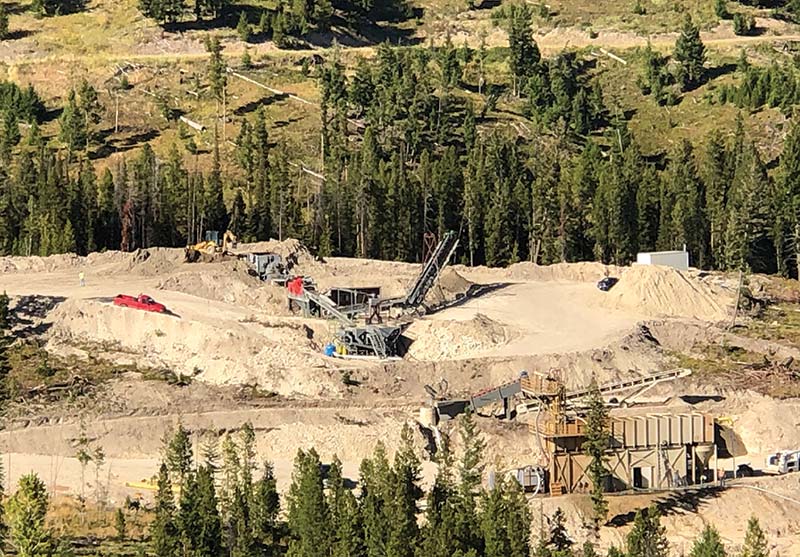Estimated reading time: 6 minutes
Sapphires from Montana have seen growing interest over the last few decades by a multitude of jewelers—not only in the U.S. but around the world—who feature the colorful gems in their collections. Montana sapphires are also attracting young brides who want to have an ethically sourced stone in their engagement ring. To learn more about the area and how mining fared during the pandemic, we spoke with Warren Boyd, Director of Marketing, Potentate Mining LLC, which has been active in Rock Creek since 2016.

Although much attention is paid to Montana sapphires today, they are not new. The first gems were discovered in 1892 by M.H. Bryan who was prospecting for gold on the West Fork of Rock Creek. He was intrigued by the shiny pebbles and scooped some up for his grandchildren. When they turned out to be sapphires, miners began to find them in abundance in the area. These American gems were then displayed at the Paris Exposition in 1902. One of the first jewelers to feature them was Tiffany & Co.
Sapphires are mined in several areas in Montana. Small-scale production is carried out in alluvial benches in the Missouri River, with a total of 3 tons of sapphire extracted since discovery. Mining, also alluvial, has currently dried up at Dry Cottonwood Creek as the area has been fully reclaimed.
Unlike the other regions, the sapphires from Yogo Gulch are found in hard rock. Most of Yogo gems are blue, with a very uniform, intense color, and they don’t require heat treatment. Up to 2014, about 3.5 tons were mined, although currently there is no production. Yogo sapphires appearing on the market today are from mine tailings or estate pieces, and very rarely are found in larger sizes.
The most prolific sapphire mining area is Rock Creek, where historically 91% of production in Montana has occurred. More than 65.8 tons of sapphires were mined from the early part of the 20th century to 2014. The gems are found in heavily weathered volcanic rocks and secondary concentrations in small gulches. This very rich deposit covers more than 3500 acres, of which 90% of this area is owned by Potentate Mining, which began significant production starting in 2016.
In addition to commercial mining, Potentate sells its rough sapphires to the local tourist operations through its CSR policies. Thousands of tourists visit these local operations—supported with sapphires from Potentate’s operation—so they can wash gravels to recover their own sapphires. Families arrive from all around North America to screen and pan gravel for these colorful gems.
So how has this all changed during the pandemic? “The smallscale producers at the Missouri River continued to operate,” says Warren Boyd. “And, we kept our commercial operations going, too, but with a smaller staff. But no visitors or tourists were allowed.” In 2019, Potentate commissioned a new plant, which allowed for less staff and increased volume, so that in 2020, the company was able to still produce about 80%-90% of what it did in 2019.
“Mining is seasonal,” adds Boyd, “It starts in late April, with processing in late May, until late October, thus summers are focused on production and winters are for sales.” Because Potentate sells almost all its gems as rough, Winter 2020 posed some logistical challenges in terms of getting the gems to clients. He notes that the company cuts, however, some of its gems, about 0.5%, that are very high-value stones.
Yet, he noted that Potentate’s customers, who had their stones cut in India and Sri Lanka, had a very hard time, since these cutting centers were working at only 30-40% capacity. For those who cut their stones in New Jersey, there was no slowdown as robots did most of the faceting.
For this 2021 season, Potentate doubled its staff, and is working double shifts. “Finding staff has been an issue,” he confides, “because of the government aid to workers. The company, on the other hand, did not receive any money from the government.”
In keeping with its target of environmental protection, it added a new water recycling plant that allows the miner to recycle up to 90% of the water. “We are the only colored gemstone operation in North America that uses water clarifiers,” he smiles.
The colors of the sapphires that come out of the mines in Rock Creek are generally blue-green, teal and greenish blue, while rarely, they find shades of padparadscha, orange, pink and even a few rubies. The largest North American colored gemstone producer, Potentate has many years ahead to produce these beautiful and ethically sourced sapphires from Rock Creek.
Photos are courtesy of Potentate Mining unless otherwise indicated.